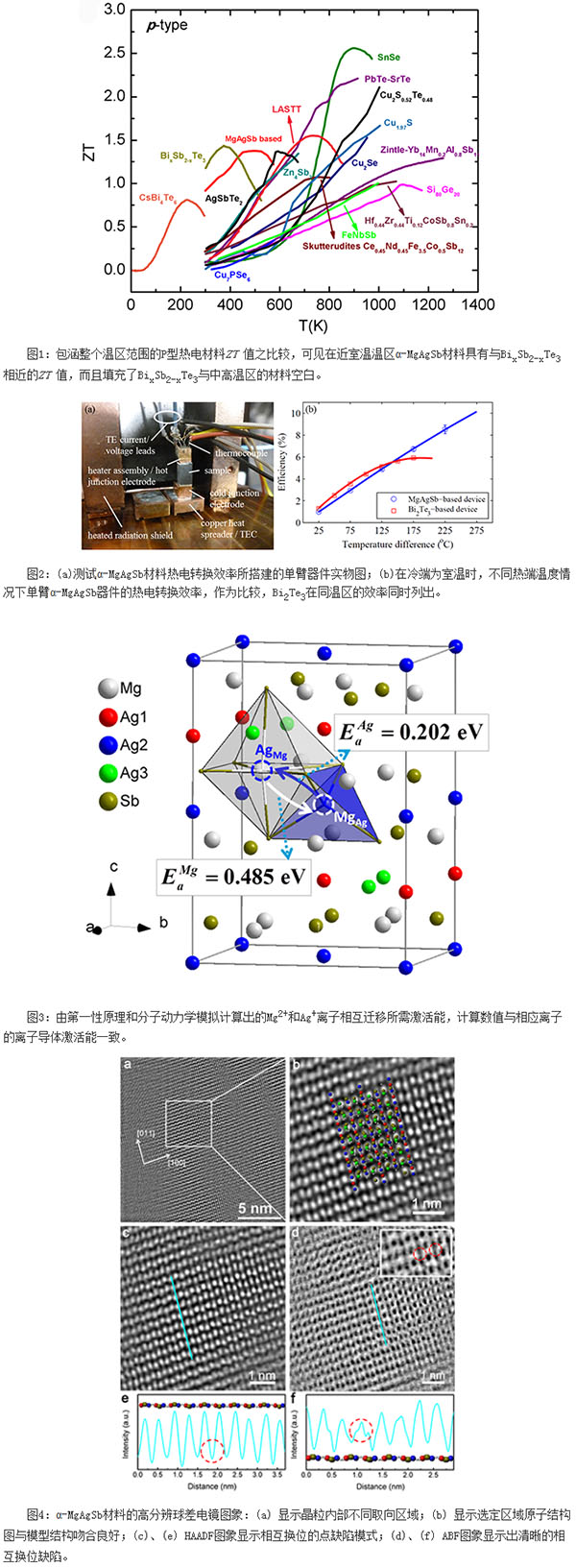
As a new type of clean energy material, thermoelectric materials can directly convert heat energy and electric energy, at the same time, they have the advantages of small size, no noise, long life, no pollution to the environment, etc., and have unique advantages in energy utilization. Therefore, it has attracted wide interest from various countries. The energy conversion efficiency of a thermoelectric device is mainly determined by the performance of the thermoelectric material, and the energy conversion efficiency η is determined by the ZT value of the thermoelectric material. The value is defined as: ZT=(S2/Ïκ)T. The Seebeek coefficient and conductivity are referred to as the electrical properties of the material. They describe the transport properties and interactions of carriers during the electrical transport of materials, and the carrier concentration, carrier mobility, and energy band structure of the material. There is a very close connection. Three parameters that determine the performance of thermoelectric materials: Seebeck coefficient, conductivity, and thermal conductivity Ƙ are coupled to each other through carriers and show the opposite trend.
Although thermoelectric materials have been developed for several decades, the energy conversion efficiency of commercial devices has been less than 6%, which is mainly due to the low ZT of traditional thermoelectric materials. Traditional thermoelectric materials are mainly concentrated on Bi2Te3, PbTe, and SiGe systems. Bi2Te3 is currently the only commercially available material. The devices constructed are widely used in refrigerators and other refrigeration industries, and in the field of waste heat power generation below 250 degrees Celsius. However, Bi2Te3 material itself has some significant defects, such as poor mechanical properties, and difficulties in the development of electrode materials in the device process, which limits the further promotion of such materials. In recent years, remarkable achievements have been made in the exploration of new types of thermoelectric materials, especially in medium-high temperature materials, such as the alloys of Skutterudites (ZT~1-1.5) and Half-Heuslers (ZT~1) as shown in Figure 1 below. With the compound. However, near the room temperature zone, high ZT materials are still very scarce, as shown in Figure 1. Therefore, the development of new thermoelectric materials near room temperature zone is of great significance.
Since 2014, Zhao Huaizhou, an associate researcher at the Institute of Physics, Chinese Academy of Sciences/Beijing Advanced Laboratory of Condensed Matter Physics, has made important progress in thermoelectric materials and device development near room temperature. In cooperation with Professor Ren Zhifeng of the University of Houston, Zhao Huaizhou et al. first reported the synthesis and thermoelectric properties of P-type tetragonal crystal structures of α-MgAgSb-based materials. It was found that the ZT value of Ni-doped α-MgAgSb at room temperature reached 0.9, and the peak value was broad. Located around 200 degrees Celsius, reaching ~1.4, filled with the temperature gap between the Bi2Te3 material and the intermediate temperature zone material, has important scientific significance and application value.
The paper was published in the form of a newsletter in NanoEnergy, 7, 97 (2014). Regarding the thermoelectric device structure, α-MgAgSb also has unique advantages. In the case of a cold-junction at room temperature and a temperature difference of 225 degrees Celsius, only the single-arm device conversion efficiency reaches 8.5%, and the Ag electrodes are once prepared using a hot press method. The contact resistance with the material is low and there is no interface reaction, and at the same time, the mechanical performance is excellent in all aspects. The commercial Bi2Te3 material was used as a reference and the energy efficiency test results are shown in Figure 2b below.
By comparing the two, it is evident that the overall performance of α-MgAgSb is superior to that of Bi2Te3. It is entirely possible for α-MgAgSb to substitute for the thermoelectric power generation of Bi2Te3 at temperatures below 300 degrees Celsius. Related papers were published in EnergyEnviron.Sci.8, 1299 (2015). This achievement laid the foundation for the further research and development of thermoelectric devices near the room temperature zone, and broadened the application of thermoelectric materials in the entire temperature range.
Recently, in order to further reveal the thermoelectric mechanism of α-MgAgSb-based materials and further optimize the material properties, Zhao Huaizhou cooperated with researchers of the Advanced Materials Laboratory, Chen Xiaolong and Gu Lin, and directed doctoral student Li Dandan to calculate first-principles and dynamics, and based on The structural characterization methods of X-ray diffraction and spherical aberration electron microscopy have revealed that in the α-MgAgSb structure, Mg ions occupying tetrahedral voids and specific Ag ions occupying octahedral voids adjacent to each other have migration and transposition characteristics, and their migration activation energy Similar to the corresponding Ag ions and Mg ion conductors, as shown in Figure 3 below. However, spherical aberration electron microscopy clearly reveals the continuous transposition defect structure caused by migration (Fig. 4). With the assistance of Sun Peijie, an extreme conditions laboratory researcher, and Qi Xuekui, a research associate of the magnetics laboratory, the material sound velocity test, the low temperature Debye temperature test, and the 25Mg atomic NMR test all provide strong evidence for this ion migration characteristic, similar to the behavior in thermoelectricity. The field of materials is very rare. This work reveals the microstructure of ultra-low thermal conductivity of α-MgAgSb thermoelectric materials, and has guiding significance for the discovery of new thermoelectric materials.
Related papers were recently published in the material science publication AdvancedFunctionalMaterial (DOI:10.1002/adfm.201503022).
The above work was supported by the National Institute of Physics' 100-person plan and advanced materials laboratory funding and the Chinese Academy of Sciences.
Camping Lamp,Portable Retro Camping Lamp,Led Camping Lamp,Creative Camping Lamp
Land of Lights Electric Appliance Co., LTD , https://www.loloutdoorlight.com